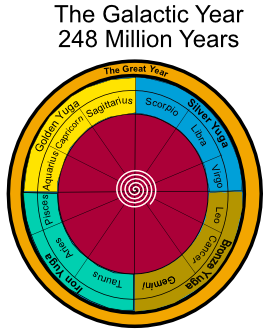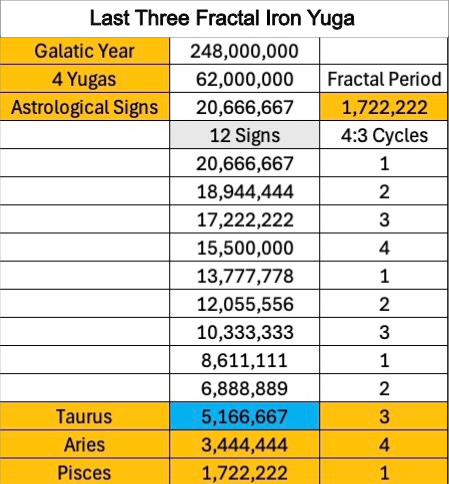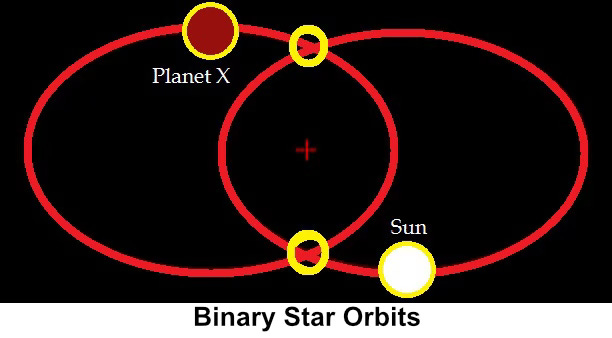The long term history of Earth has been described by ancient Indian cosmology, through vast cycles of time known as Yugas, each representing a distinct era with varying levels of human virtue, wisdom, and connection to the divine. According to the Hindu Puranas, these four Yugas are Satya Yuga (Golden), Treta Yuga (Silver), Dvapara Yuga (Bronze) and Kali Yuga (Iron Age), together forming a complete cycle called a Mahayuga. The Satya Yuga, or the Golden Age, is a period of purity and spiritual advancement, where humans live in harmony with nature and each other. Over time, virtue and moral integrity deteriorate as the world progresses through the Treta and Dvapara Yugas. Finally, in Kali Yuga, humanity experiences strife, moral decline, and disconnection from spiritual truths. After Kali Yuga, the cycle is believed to restart with a new Mahayuga. We are currently ending the Kali Yuga and entering into a new Golden Age.
The cause of these Yugas are possibly due to our sun has a twin forming a Binary Star System. The interactions of these binary suns at time create extinction events. Researchers such as, Walter Cruttenden has been studying this subject for the last ten years.
In Walter Cruttenden book, “Lost Star of Myth and Time,” explores the idea that the Sun is part of a binary star system, which may affect Earth’s precession and lead to cycles of cultural rises and falls, such as the “Golden Ages” and “Dark Ages” seen throughout history. Drawing from ancient myths and modern astronomical theories, Cruttenden argues that this celestial relationship influences human evolution and civilization. The book blends mythology, astronomy, and esoteric knowledge to propose an alternative view of history based on cosmic cycles and our place in the universe.
Astronomers Dr Sarah Sadavoy and Dr Steven Stahler’s have also suggested that the Sun, like many stars, may have been born with a twin. Their study, based on observations of young stars in the Perseus molecular cloud, proposes that nearly all Sun-like stars initially formed as part of binary or multiple star systems. Dr Richard Muller and Dr Robert Rhode, propose “The Nemesis hypothesis” that the Sun may have a companion star, dubbed “Nemesis,” which could periodically disturb the Oort cloud, sending comets toward Earth. This influx of comets could lead to mass extinction events.
During times when these binary stars interact, scientists Raup and Sepkoski discovered a regularity in mass extinctions events. Nemesis is hypothesized to be a red dwarf or brown dwarf star orbiting far outside the edge of the solar system. These events were discovered in a paper called “Periodicity of Extinctions in the Geologic Past” by Dr. David Raup and Jack Sepkoski, published in 1984, proposed that mass extinctions on Earth follow a periodic pattern, occurring approximately every 26 million years. By analyzing the fossil record, Raup and Sepkoski identified cycles of extinction that suggested a regular timing of these catastrophic events, affecting marine and terrestrial life. (see references)
On a smaller scale, the Great Year has been closely tied to the “precession of the equinoxes,” having its roots in ancient Babylonian and Greek cosmology. While the Babylonians (1900–500 BCE) developed sophisticated astronomical systems and understood the importance of long-term celestial cycles, it was the Greeks who formalized the idea. Greek philosophers, such as Heraclitus in the 5th century BCE, first hinted at cosmic cycles, and Plato (4th century BCE) later expanded on this, referring to the "perfect year" or cosmic cycle in which the sun, moon, and planets would complete a full revolution relative to the fixed stars. This notion, later known as the **Great Year**, reflected an understanding of vast, repeating cycles in Earth history.
The discovery of the **precession of the equinoxes** by the Greek astronomer **Hipparchus** around the 2nd century BCE gave the Great Year a more concrete astronomical basis. Hipparchus observed that the positions of the stars were slowly shifting relative to the Earth’s equinox points, a phenomenon that takes approximately 25,920 years to complete a full cycle. This discovery laid the foundation for the modern concept of the Great Year, where each zodiac sign rules for 2,160 years, leading to the idea of Astrological Ages forming the Great Year cycle.
In Roman times, thinkers such as **Macrobius** expanded on these ideas, linking them to cycles of creation and destruction. By the 1st century CE integrated the Great Year into their astrological writings. The concept persisted through the Middle Ages and Renaissance, where it was further explored by astrologers seeking to understand cosmic cycles and human destiny in relation to the universe’s grand timeline. The Great Year continues to be a symbolic representation of the vast cycles governing cosmic and astrological events, rooted in the precession of the equinoxes discovered by Hipparchus.If we use Earth’s precession of the equinoxes, the Yuga calendar began to incorporate the twelve astrological signs.
The Great Year is organized into four Yugas, 12 astrological signs and 48 historical periods or four per sign. The 1, 4, 12, 48 series represents a 4:3 fractal ( 4 = 1x4, 3 = 4x3=12). The **4:3 ratio** is significant across various fields, including music, geometry, number theory, physics, and chaos theory. In music, it defines the interval of a **perfect fourth** in Pythagorean tuning, where one note's frequency is 4/3 of another, creating a harmonic relationship essential to musical structure. In geometry and architecture, the 4:3 ratio is valued for its aesthetic appeal, often used in classical design principles, such as in the proportions of rectangles. In Number Theory, it simply represents a mathematical relationship where for every 4 units of one quantity, there are 3 units of another, serving as a foundation for fractions and proportional reasoning.
In physics, especially in wave phenomena, the 4:3 ratio often appears in systems with harmonic oscillations and resonances, where certain frequencies resonate with each other in simple ratios. This resonance can play a role in chaotic systems as they transition from order to disorder. Finally, in fractal geometry, closely related to chaos theory, ratios govern the self-similar patterns in fractal structures, though 4:3 isn’t a primary feature. However, in specific systems with resonance or periodic behavior, the 4:3 ratio may emerge, contributing to the overall complexity of these chaotic systems.
If we apply this 4:3 ratio to the Solar System galactic journey taking around 248 million years, each Yuga occurs every 62 million years and the 12 astrological signs would have a 20,666,667 million years period. The last Yuga era in this galactic journey began in Taurus showing the beginning of the Iron Yuga as seen in the table below.
The number 12 is also a form of the 4:3 ratio. Thus, to create a 4:3 fractal set, one divides the selected period by 12. The last number of the progression represents the fractal period as seen in the table above. If the time period has fractal properties, you will get repeating digits as seen in the table above. The Age of Taurus in the galactic cycle highlighted in blue covers a five million years period. Each succeeding data point represents a fractal of the previous period but also a fractal of the Galactic Year as a whole.
Time is not only occurring through the passing of minutes, hours and days but also moving through fractal periods of resonance in history influenced by its Yuga. Fractals in nature reveal the self-repeating patterns that can be seen across various natural systems, from the branching of trees and rivers to the structure of mountains, clouds, and even human blood vessels. A fractal is a complex geometric pattern that, when magnified, reveals similar structures at increasingly smaller scales, creating a sense of infinite detail.
In nature, fractals provide efficient ways for systems to organize themselves, such as in the way leaves are arranged to maximize sunlight exposure or how lightning branches to distribute energy. These patterns emerge from simple mathematical rules but lead to highly complex and often chaotic forms, making fractals essential for understanding natural processes that are seemingly random but have underlying order. Fractals help scientists describe irregular shapes and phenomena that traditional geometry struggles to capture, offering insights into the intrinsic complexity of the natural world.
The Age of Taurus in this cycle, has three major magnetic pole reversals, the Cobb Mountain subchron, the Matuyama-Gauss Chron, and the Kaena subron. The Cobb Mountain subchron geomagnetic reversal occurred approximately 1.2 million years ago during the Matuyama Reverse Chron, a period when the Earth's magnetic field was primarily oriented in the opposite direction from today. This event, lasting around 20,000 years, represents a short interval of normal magnetic polarity within a longer period of reversed polarity. The reversal was identified through the study of volcanic rocks and sediments, particularly in the Cobb Mountain area of California, which preserve the ancient magnetic field directions.
The Matuyama-Gauss Chron occurred approximately 2.58 million years ago and marks a significant event in Earth’s geologic history when the planet’s magnetic field flipped. This transition reversed the polarity to normal polarity (when the magnetic north aligns with the geographic north). The Matuyama-Gauss reversal coincides with the beginning of the Quaternary period and the onset of glaciations (Ice Ages). These pole reversals are not uncommon in Earth’s history, but they offer critical insight into the planet’s magnetic dynamics and have been linked to shifts in climate and tectonic activity during that period.
The Kaena Subchron was a geomagnetic event, specifically a brief period of reversed magnetic polarity that occurred during the Matuyama Chron, which itself is a period of predominantly reversed polarity. The Matuyama Chron lasted from around 2.58 million years ago to approximately 780,000 years ago. Within this overall reversed polarity era, the Kaena Subchron represents a short interval where the Earth's magnetic field flipped to a normal (i.e., today's) polarity.
During the Maturyaa-Gass pole reverse around 2.58 million years ago, a megafaunal extinction occurred simultaneously with the onset of the Quaternary period and the end of the last Ice Age around 10,000 years ago. This led to the disappearance of a large number of species, particularly the megafauna—large-bodied animals such as mammoths, saber-toothed cats, and giant ground sloths. Though this extinction event happened long after the Matuyama-Gauss reversal, the broader environmental changes during the Pleistocene, included glaciations, shifting climates, and possible human activity, are thought to have contributed to the extinction of these species lasting until 780,000 years ago.
In addition, the emergence of the genus Homo also emerged during this period around 2.8 to 2.5 million years ago in Africa. This species, Homo habilis, is considered the earliest member of the Homo genus initiated its evolution. Homo habilis is often credited with developing more advanced stone tools than its ancestors, particularly the Oldowan tool culture. The emergence of Homo habilis coincides with environmental changes in Africa, including a shift to drier, more open landscapes, which may have driven adaptations in bipedalism, tool use, and diet. Over time, this lineage led to the evolution of later human species, such as Homo erectus and eventually Homo sapiens.
During pole reversals, the Earth’s magnetic field weakens and becomes disordered, eventually leading to the north and south magnetic poles switching places. As the field weakens, Earth is less shielded from cosmic rays and solar wind, which could disrupt satellite communications, GPS, and power grids, and increase radiation exposure, particularly near the poles. Animals that rely on the magnetic field for navigation, like migratory birds, may experience disorientation. This increased radiation could have affected life on this planet, altering its DNA.
Around the time of Cobb Mountain subchron between 1.2 to 0.7 million years ago, the Mid-Pleistocene Transition (MPT) occurs causing significant climatic shifts that changed Earth’s glacial cycles. Before this transition, the planet experienced relatively regular glacial-interglacial cycles every 41,000 years, driven by changes in Earth’s axial tilt (obliquity). However, during the MPT, these cycles became longer, stretching to about 100,000 years, and the glaciations grew more intense. This shift is believed to have been influenced by changes in Earth’s orbital patterns, ice sheet dynamics, and carbon cycle feedbacks. The last recorded pole reversal occurred 780,000 years ago called the Brunhes-Matuyama.
During the last pole reversal, the Homo species took a dramatic jump in its evolution. Between 600,000 to 800,000 years ago our last common ancestor of Homo sapiens emerged through the discovery of Homo heidelbergensis. This species, found in Africa and Europe, is thought to have given rise to both modern humans and archaic species like Neanderthals and Denisovans. Homo heidelbergensis exhibited key human traits such as bipedalism, tool use, and social structures, setting the stage for the cognitive and cultural evolution of Homo sapiens.
Earth cyclical pole reversals could be caused through the interaction of our Sun with its binary star Nemesis. As these two stars approach each other they begin to orbit around each other. These Suns will begin an inner orbit having two major points as seen in the picture below. One point occurs, as they approach each other and another when they move into their outer orbits.
Other dynamic effects of this binary star involves the gravitational pull of Nemesis. A hypothetical large planet beyond Neptune, suggests that it could have significant effects on the Kuiper Belt, particularly in perturbing the orbits of objects and possibly bringing comets into the inner solar system. Some scientists propose that the gravity of Nemesis could disrupt the orbits of Kuiper Belt objects (KBOs) at the edge of the solar system, sending them toward the Sun and creating long-period comets. Additionally, this large, distant planet might explain the unusual clustering of orbits seen in certain KBOs. Nemesis size has been estimated to be 5 to 10 times of our Sun. These theories aim to account for observed anomalies in the outer solar system, though Nemesis existence remains speculative.
An example of comets being pulled out of the Kuiper Belt by Nemesis, could be the cause of the Younger Dryas Impact Theory that proposes around 12,800 years ago, during the onset of the Younger Dryas period, a comet or asteroid impact triggered abrupt climate changes. This event is believed to have caused widespread fires, significant cooling, and environmental disruptions, contributing to the extinction of large Ice Age animals, such as mammoths, and possibly affecting early human populations like the Clovis culture in North America. Evidence for the theory includes impact-like materials such as nanodiamonds and iridium found in geological layers. However, the theory remains debated, with some scientists questioning the strength of the evidence.
By 1200 BCE, the mysterious collapse of the Bronze Age occurred, marked by the sudden fall of major civilizations, including the Mycenaeans, Hittites, and Egyptians. This period saw widespread destruction, population decline, and the abandonment of cities. Possible causes include invasions by the mysterious "Sea Peoples," internal rebellions, natural disasters like earthquakes, and climate change leading to drought and famine. The aftermath led to the Greek Dark Age, lasting roughly from 1100 to 800 BCE, characterized by the loss of literacy, trade, and art, as well as smaller, isolated communities.
What began as Nemesis entry 12,800 years ago, ends with Nemesis exiting its close orbit to the Sun moving into its outer orbit. A possible sighting of this event occurred when a red star was recorded by the Babylonians, around 1000 BC. This was reference in a Babylonian tablet, called the MUL.APIN. Michael Heiser, an expert in Sumerian cuneiform language translated this section as stating,
“the red star which stand in the south of the night … the Star of Marduk, Nibiru…crosses the sky“ (pages 36-37).
Heiser believed, that the reference of Nibiru symbolized a crossing a point in the night’s sky. The planet Marduk, which represents Jupiter, could have been used to identify the red star relative position in the sky. Before this sighting the Collapse of the Bronze Age had already began. A chaotic period follows sighting, known as the Greek Dark Ages that lasted for 250 years. The red color of the star, could be an identifying it as a red dwarf sun as predicted in its theory. Nemesis is pulling KBO’s (comets and asteroids) towards the solar system, Nemesis orbit is probably perpendicular to the Solar Plane where its entry and exit points crosses it relative to its position outside of the solar system. During its closes path to the solar system Nemesis is underneath the solar plane and could only be observed by the South Pole.
If the Younger Dyas Impact 12,800 years ago signaled Nemesis entry point towards the solar system,, its exit point was 3,000 years ago, this represent an estimate of Nemesis closest orbit around the sun is between 12,000 to 13,000 years. This range is larger due to the difficulty in determining Nemesis location as the asteroids in the Kuiper Belt are pulled towards our solar system and the time it takes for these objects to enter Earth’s atmosphere. By doubling this range, it’s close to the 25,920 period of the Precession of the Equinoxes. Cruttenden proposed the cause of the tilt of Earth axis and precession could be affected by Nemesis gravitational pull as seen through the extreme axis tilts of Neptune and Pluto. The Kali Yuga could represents Nemesis last stage of its closes orbit with our sun. Following this period is the Age of Pisces of 2160 years showing Nemesis influence begins to fade, allowing other cosmic influences to take place, i.e. the Golden Age. According to Cruttenden we passed from the Iron Yuga into the Golden Yuga at the end of 2013.
Within eleven years of this date, a rapidly changing world of electric vehicles, artificial intelligence and a growing reorganization of the planet is taking place. Earth will be always be a challenging planet but without Nemesis influence, the truth of Earth ancient history and our full potential will unfold.
References:
David M Raup and J John Sepkoski, Jr, “Periodicity of Extinctions in the Geologic Past”,






